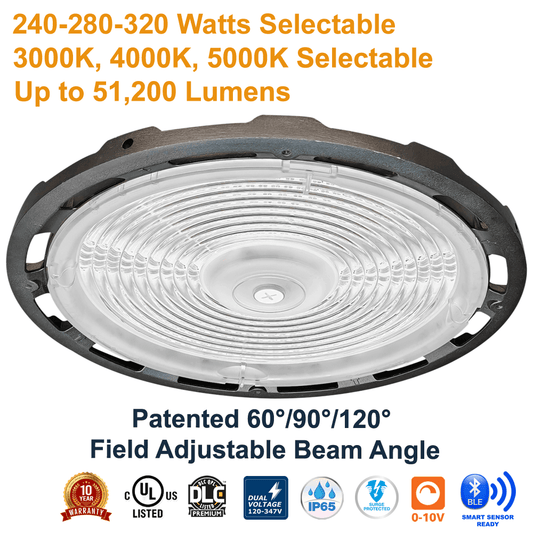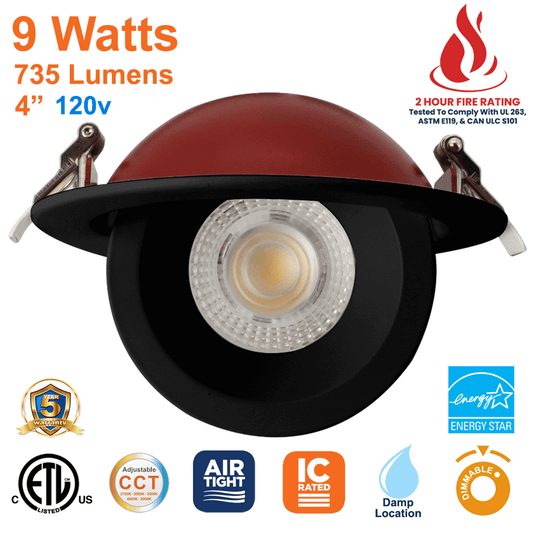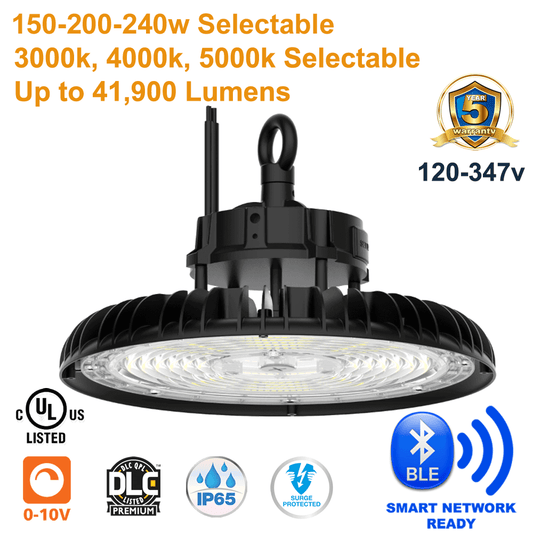In this comprehensive guide, we explore the intricacies of LED Pot Light Spacing, ensuring that you make the most out of your lighting setup. LED Network offers an extensive range of Commercial LED Lighting and Networked Lighting Controls across multiple brands. Whether you are looking to illuminate a cozy home space or brighten up a commercial area, understanding the nuances of Pot Light spacing is crucial. From the size of the recessed lights to the color temperature and lumen output, every detail plays a pivotal role in creating the perfect ambiance.
Table of Contents
- What is an LED Pot Light
- Is 4 or 6 inch Recessed Lighting better?
- How do I calculate the number of Recessed Lights do I need for my space?
- What is the best way to calculate a Recessed Lighting layout?
- How do you calculate Down Light spacing?
- Does a Pot Light’s colour temperature change the number of fixtures I need?
- How does a Down Light’s lumen output affect spacing?
- What is the rule of thumb for Downlight spacing?
- What is the maximum distance that 4 inch Pot Lights should be apart from each other?
- What is the maximum distance that 6 inch Pot Lights should be apart from each other?
- How do I avoid dark corners in my Recessed Lighting layout?
- Should my Pot Light layout change based on a fixture’s beam angle?
- Should my Down Light layout change based on a room’s ceiling height?
- How far apart should hallway Recessed Pot Lights be?
- How far apart should Recessed Lights be in a bathroom?
- How far apart should kitchen Pot Lights be?
- How far apart should Downlights be in a basement?
- Conclusion
- Frequently Asked Questions
What is an LED Pot Light
LED Pot Lights, also known as recessed lights, are a popular choice for both residential and commercial spaces. They are installed into the ceiling, providing a sleek and modern look. The Pot Lights Collection at LED Network showcases a variety of options to choose from. These lights are not only energy-efficient but also offer a focused illumination, making them perfect for highlighting specific areas or objects in a room.
Is 4 or 6 inch Recessed Lighting better?
When it comes to choosing between 4 or 6 inch recessed lighting, it boils down to the specific needs of your space. 4-inch lights are ideal for smaller areas and often provide a more focused beam of light. They are perfect for accent lighting, highlighting artwork or architectural features. On the other hand, 6-inch lights commonly offer a broader spread of light, making them suitable for general lighting in larger spaces. The choice also depends on the ceiling height and the overall design of the room.
How do I calculate the number of Recessed Lights do I need for my space?
Calculating the number of recessed lights required for a space involves considering various factors such as room size, ceiling height, and the purpose of the lighting. A general rule of thumb is to divide the height of the ceiling by two to determine the spacing between the lights. For instance, if you have a ceiling that is 8 feet high, the lights should be approximately 4 feet apart. However, this is a basic guideline, and other factors such as the type of lighting and the level of brightness desired should also be taken into account.
What is the best way to calculate a Recessed Lighting layout?
A well-planned recessed lighting layout enhances the aesthetics and functionality of a space. To calculate the best layout, start by determining the focal points in the room that require accent lighting. Next, consider the areas that need general lighting. Ensure that the lights are evenly spaced to avoid dark spots and create a harmonious balance. Utilize the Recessed Lighting Collection at LED Network to find fixtures that suit your specific needs.
How do you calculate Down Light spacing?
Down Light spacing is crucial for achieving a well-lit space without any dark spots. To calculate the spacing, consider the beam angle of the downlight and the height of the ceiling. A narrower beam angle requires closer spacing, while a wider beam angle allows for more distance between the lights. Additionally, higher ceilings may require lights to be spaced closer together to maintain the desired level of brightness.
Does a Pot Light’s colour temperature change the number of fixtures I need?
The colour temperature of a pot light can indeed influence the perception of brightness in a space, and subsequently, the number of fixtures you might need. Warmer tones, typically around 2700K, create a cozy and inviting atmosphere but may require more fixtures to achieve the same level of perceived brightness as cooler tones. Cooler temperatures, around 5000K, provide a crisp and alert ambiance, potentially reducing the number of fixtures required. For a comprehensive understanding of colour temperature, refer to What is Colour Temperature & Why is it Important for Lighting.
How does an LED Downlight’s lumen output affect spacing?
Lumen output is a critical factor in determining the spacing of LED downlights. Higher lumen output means more brightness, allowing for wider spacing between fixtures. Conversely, lower lumen output may necessitate closer spacing to achieve the same level of illumination. It’s essential to balance lumen output and spacing to ensure even and adequate lighting throughout the space. For more information on lumens, check out Everything You Need to Know About Lumens.
What is the rule of thumb for Downlight spacing?
A general rule of thumb for downlight spacing is to divide the ceiling height by two to determine the distance between fixtures. However, this can vary based on the specific lighting needs of the space and the fixtures’ lumen output and beam angle. It’s crucial to consider these factors to achieve a balanced and well-lit space.
What is the maximum distance that 4 inch Pot Lights should be apart from each other?
For 4-inch pot lights, a maximum spacing of 4 feet is typically recommended to ensure even lighting without dark spots. This spacing can provide adequate illumination for general lighting purposes while maintaining a sleek and uncluttered ceiling appearance.
What is the maximum distance that 6 inch Pot Lights should be apart from each other?
6-inch pot lights have a broader beam spread, allowing for a maximum spacing of up to 6 feet apart. This makes them suitable for larger areas, providing sufficient illumination while maintaining a balanced aesthetic.
How do I avoid dark corners in my Recessed Lighting layout?
Avoiding dark corners in a recessed lighting layout requires careful planning and consideration of the room’s dimensions and the fixtures’ placement. Ensure that lights are placed closer to the walls and corners to eliminate shadows and create a uniform lighting experience. Utilizing adjustable or gimbal recessed lights can also help direct light towards darker areas, enhancing overall illumination.
Should my Pot Light layout change based on a fixture’s beam angle?
Yes, the beam angle of a pot light significantly influences the layout. Narrow beam angles create focused and directional light, requiring closer spacing for even coverage. Wider beam angles provide a more diffuse light, allowing for wider spacing between fixtures. Selecting the appropriate beam angle for your space ensures optimal illumination and aesthetic appeal.
Should my Downlight layout change based on a room’s ceiling height?
Absolutely, the height of a room’s ceiling plays a crucial role in determining the optimal layout for downlights. In rooms with higher ceilings, lights may need to be placed closer together to maintain a consistent level of brightness throughout the space. Conversely, in rooms with lower ceilings, fixtures can be spaced further apart. It’s all about finding that sweet spot to ensure even illumination without creating overly bright or dark areas.
How far apart should hallway Recessed Pot Lights be?
Hallways, being narrower spaces, require careful consideration when it comes to pot light spacing. A good rule of thumb is to place recessed pot lights every 4 to 6 feet apart, ensuring a well-lit path without creating harsh shadows. The Drop Ceiling Lights Collection offers a variety of options that can be perfect for hallway lighting, providing both functionality and aesthetic appeal.
How far apart should Recessed Lights be in a Bathroom?
Bathrooms, often smaller and requiring precise lighting for tasks like grooming, benefit from a tighter spacing of recessed lights. Aim for a spacing of 3 to 4 feet apart, and consider the placement of other light sources like vanity lights. Explore the Bathroom Lighting Collection for fixtures that complement your recessed lighting and enhance the bathroom’s overall ambiance. Always remember, if you're installing Pot Lights in a shower or bath area, only Wet Rated Pot Lights should be used.
How far apart should LED Kitchen Pot Lights be?
Kitchens, being a hub of activity, require ample and well-distributed lighting. Space your pot lights approximately 4 to 5 feet apart, ensuring to provide adequate illumination over countertops and workspaces. The Kitchen Lighting Collection offers several lighting options to suit various kitchen layouts and styles.
How far apart should Downlights be in a Basement?
Basements, often having lower ceilings and less natural light, may require closer spacing of downlights. A spacing of 3 to 4 feet apart is a good starting point, adjusting as needed based on the specific lighting needs of the space. The Basement Lighting Collection provides a range of lighting solutions to transform your basement into a bright and inviting space.
Conclusion
Achieving the perfect LED Pot Light Spacing is an art that requires attention to detail, an understanding of the space, and the right fixtures. By considering factors such as room size, ceiling height, and the specific lighting needs of each area, you can create a well-lit and aesthetically pleasing space. LED Network is here to support you in this journey, offering a wide range of Commercial LED Lighting and Networked Lighting Controls to meet your every need. Explore our collections, read through our informative blog posts, and light up your space with confidence and style.
For more insights and tips on LED lighting, don’t forget to check out the LED Lighting Blog, your ultimate resource for all things lighting. Whether you’re installing LED pot lights for the first time or looking to enhance your existing setup, we’ve got you covered. Light up your world with LED Network.
Frequently Asked Questions
Can I Use Different Sizes of Pot Lights in the Same Room?
Yes, you can use different sizes of pot lights in the same room to create a layered lighting effect. Larger fixtures can provide general lighting, while smaller ones can be used for accent or task lighting. Ensure that the placement is strategic to maintain a balanced look.
How Do I Choose the Right Color Temperature for My LED Pot Lights?
Consider the function of the space and the ambiance you want to create. Warmer tones (2700K-3000K) are ideal for living rooms and bedrooms, creating a cozy atmosphere. Cooler tones (3500K-5000K) are better for kitchens and workspaces, providing a brighter and more alert environment.
Can LED Pot Lights Be Dimmed?
Yes, most LED pot lights are dimmable, but it’s important to ensure that both the fixtures and the dimmer switch are compatible. Check the product specifications or consult with a lighting expert at LED Network to ensure proper functionality.
How Do I Avoid Shadows When Spacing My Pot Lights?
Ensure that the lights are evenly spaced and positioned to minimize shadows. Consider the direction of the light and the placement of furniture or other objects that might cast shadows. Adjustable or gimbal recessed lights can also help direct light to reduce shadows.
What Is the Best Beam Angle for LED Pot Lights?
The best beam angle depends on the specific lighting needs of the space. Narrow beam angles (less than 40 degrees) are suitable for accent lighting, while wider beam angles (more than 40 degrees) are better for general lighting. Consider the height of the ceiling and the spacing between lights when choosing a beam angle.
How Many Lumens Do I Need for My LED Pot Lights?
The required lumens depend on the size of the space and the desired brightness level. A general guideline is to aim for 20 lumens per square foot for general lighting. However, this can vary based on personal preference and the specific function of the space.
Can LED Pot Lights Be Installed in Insulated Ceilings?
Yes, but it’s crucial to use IC-rated (Insulation Contact) fixtures that are designed to be in direct contact with insulation. Using non-IC-rated fixtures in insulated ceilings can pose a fire hazard.
How Do I Choose the Right Size of LED Pot Light for My Space?
Consider the height of the ceiling and the size of the space. Larger fixtures (5-6 inches) are suitable for higher ceilings and larger areas, while smaller fixtures (3-4 inches) are better for lower ceilings and smaller spaces.
Are LED Pot Lights Energy-Efficient?
Yes, LED Pot Lights are highly energy-efficient, consuming significantly less power than traditional incandescent or halogen bulbs. This results in lower energy bills and a reduced environmental impact.
How Long Do LED Pot Lights Last?
LED Pot Lights have a long lifespan, the majority of Pot Lights we carry have projected lifespans of 50,000 hours, or more. This is significantly longer than traditional bulbs, reducing the need for frequent replacements and providing long-term cost savings.


























